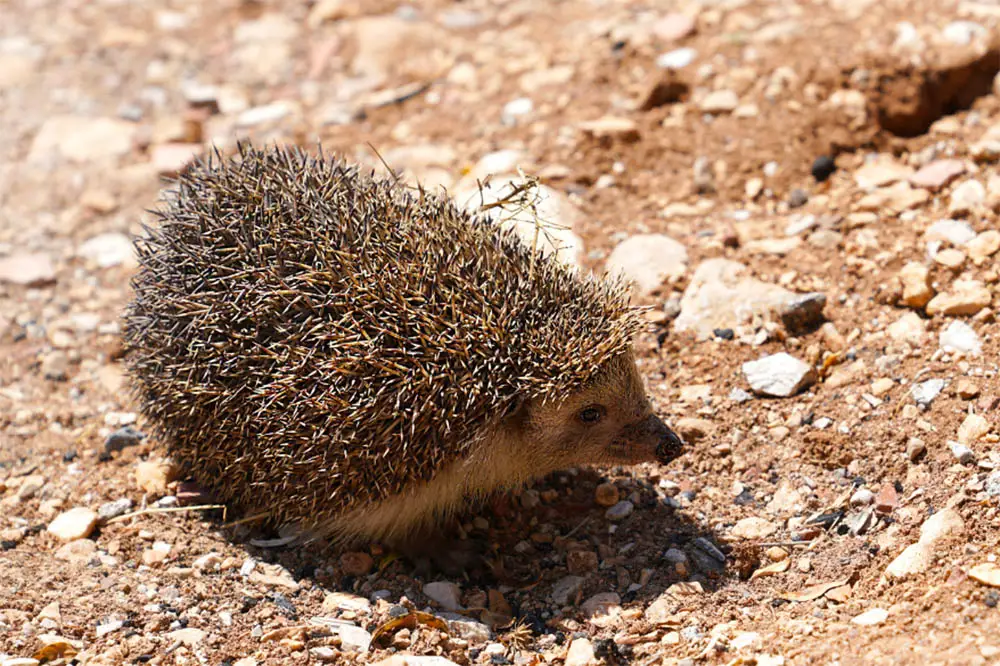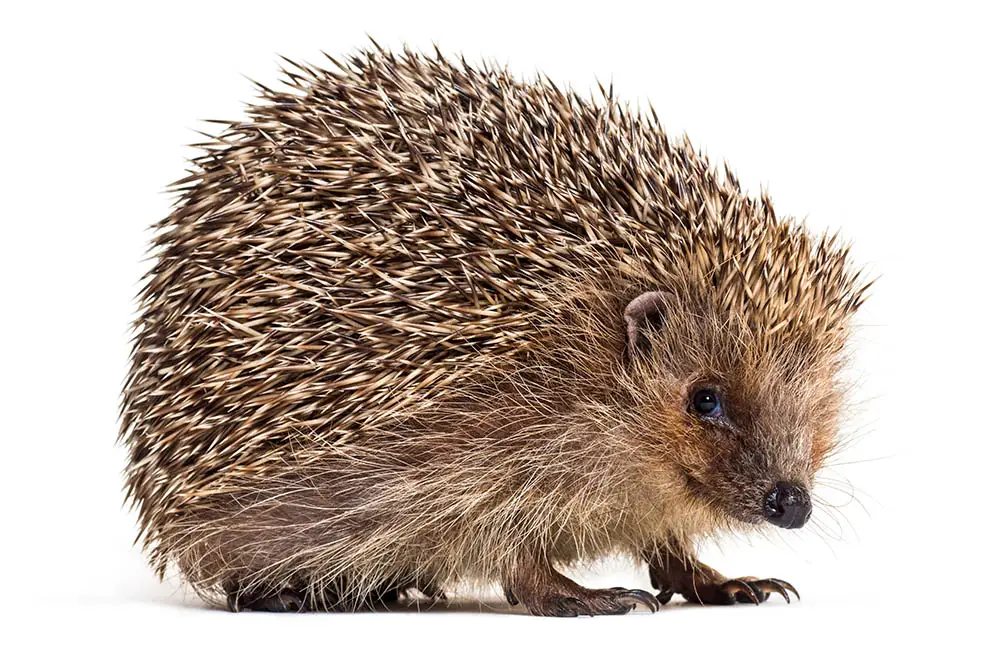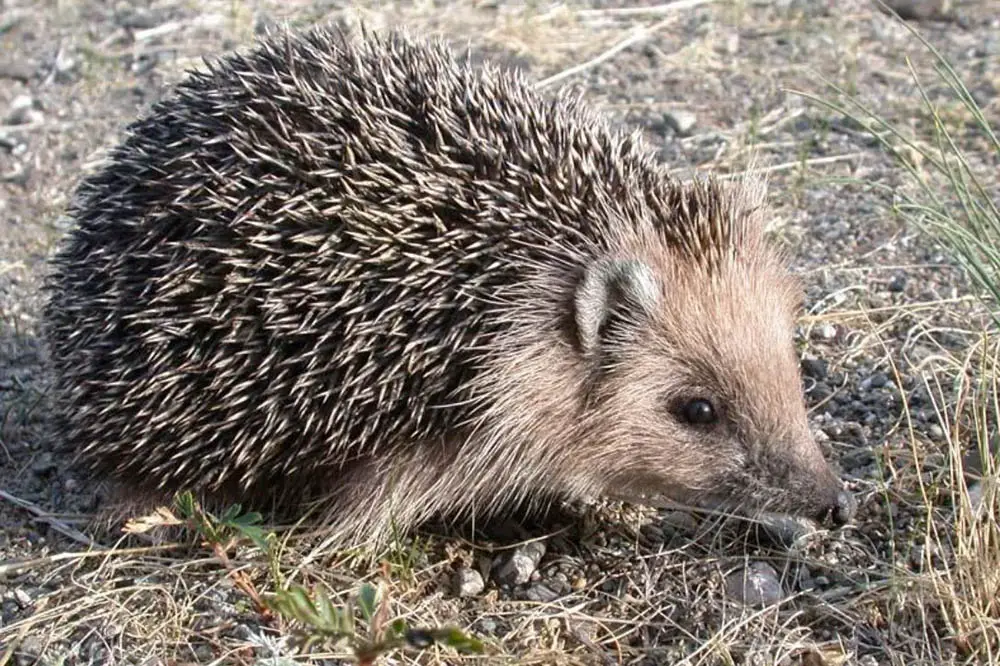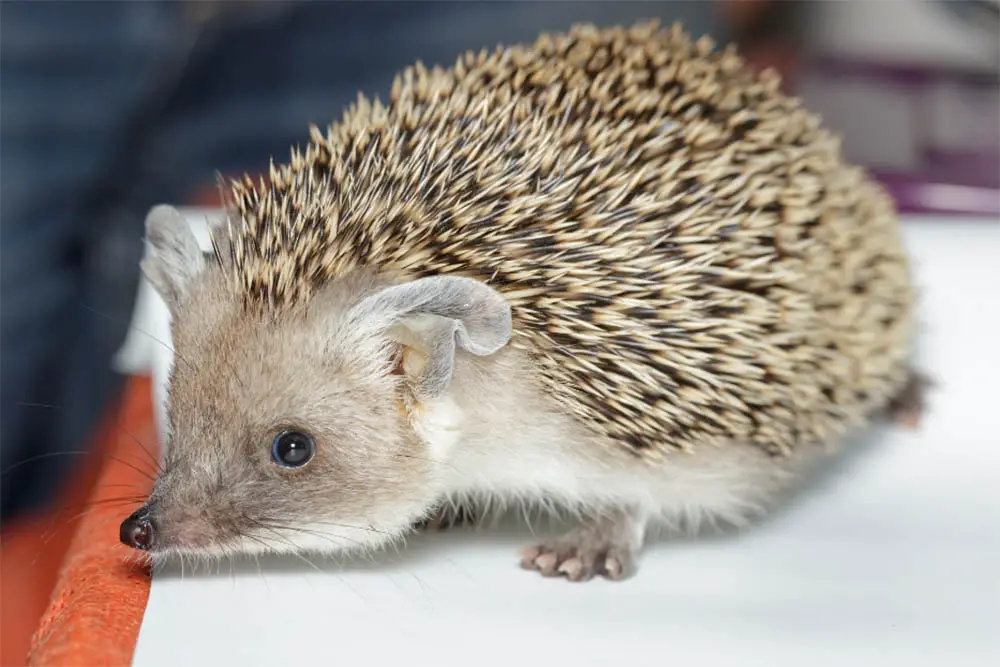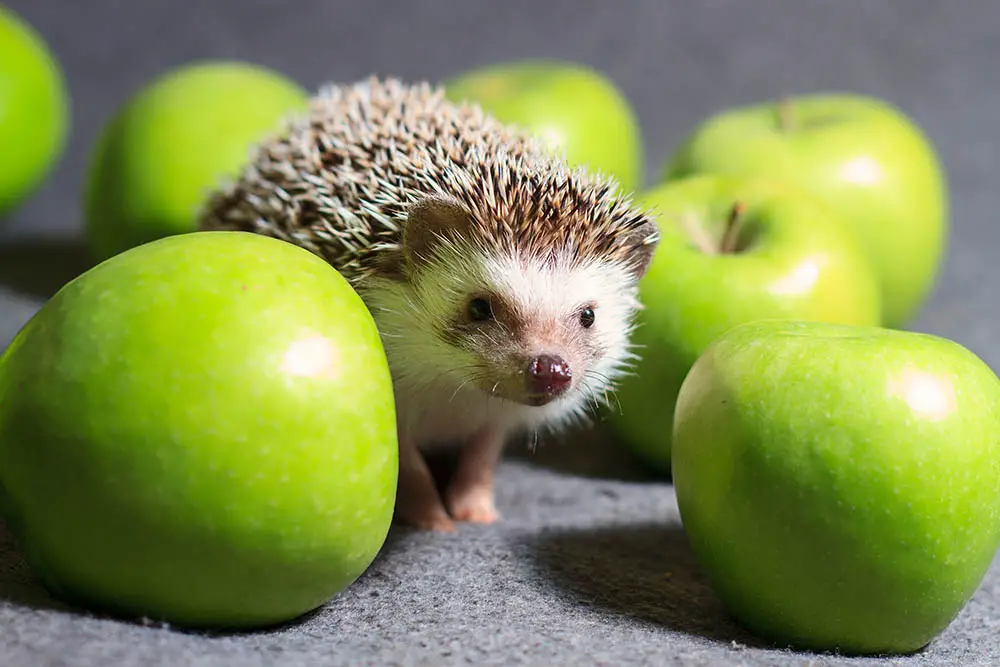The Southern African hedgehog is one of the most adorable animals on planet Earth, period! Granted, they’re not exactly bundles of fluff, rather balls of incredibly sharp spikes, yet even with a back composed of hundreds of tiny weapons, they retain their uber-cute status.
Solitary, private creatures, even amongst themselves, they rarely gift us an appearance, which can make learning about them difficult, but learn we must! Hopefully they won’t mind this spiny exposé.

We’re going to cover all the key aspects of these wonderful animals, from their distribution throughout the world to whether you can keep them as pets. Welcome to your ultimate guide to the Southern African hedgehog!
Taxonomy
The binomial Latin name for the Southern African hedgehog is Atelerix Frontalis, Atelerix translating from the Latin as ineffective fighter, and Frontalis translating as forehead.
These two translations are a little difficult to understand when put together. Sure, they’re not the best fighters in the world, as they’re a defensive animal, curling up into a spiky ball when threatened by predators, but forehead throws a spiny spanner into the works.
You’d be forgiven for thinking that Frontalis refers to the fact that their spines stop at their forehead, leaving them vulnerable or “ineffective”. The truth is a lot less complex. Frontalis simply refers to the distinctive markings on their foreheads, but more on that in a second.
Much like their European cousins, the Southern African hedgehog is a species of mammal pertaining to the Erinaceidae family composed entirely of hedgehogs and moonrats (a sort of cross between a shrew and a hedgehog).
And speaking of shrews, these hedgehogs share distant ancestry with them, moonrats being the intermediate link between the two distinct animals.
Appearance
These pointy-backed little critters have a bilaterally symmetric body shape, meaning they’re divisible into two identical halves on either side of a plane, which in their case is their spine.
As you’ve probably guessed or at least Googled, Southern African hedgehogs have the quintessential hedgehog defense mechanism: a collection of sharp spines spanning almost their entire body. Only their faces, bellies, and ears are exposed, but well hidden by fur.
The spines are made of keratin, a fibrous structural protein, the same stuff our hair and nails are made out of. It’s found throughout the animal kingdom, from the horses’ hooves to tortoises’ shells.
Each spine has a hollow shaft connected to a muscle, giving hedgehogs the ability to contract and control their spines in order to defend themselves or streamline their bodies for passage through flora and small burrows.
While the bases of their spines are always white, they tend to be brown from the middle onwards.
The wild Southern African hedgehog is a mostly dark brown creature, but a few different shades have been recorded. Southern African Pygmy hedgehogs, on the other hand, can have light brown fur, salt and pepper-style spines, and white bellies.
They have a shrew-like pointed snout, very small brown ears, and typically grow to around 20cm in length. A full-grown male can weigh as much as 350 grams, with the weight of females falling just shy of that figure.
Both front and hind paws feature five toes each, and their legs are deceptively long. They also have cute little tails that usually measure around 2cm in length.
Females normally have two pairs of nipples on their chest and one pair on their abdomen, but there have been reports of some having more than six nipples.
Of course, all this is fairly typical of hedgehogs around the globe, but the definitive characteristic of this species is the white stripe I mentioned earlier. It stretches across their forehead and from arm to arm.
It can sometimes continue over their shoulders and behind their arms, reaching as far as their abdomen.
Distribution
As you can gather from the name, the Southern African hedgehog can be found rifling through the hedgerows and fallen leaves of Southern Africa.
Their numbers are at their highest in locations such as Malawi, Botswana, Namibia, Zimbabwe, Tanzania, and of course, South Africa. So, if you’re desperate to peep one of these little fellas in the wild, you’ll have to buy a pretty pricey plane ticket.
Interestingly, there are two distinct ranges of them spread out across the southern end of the Continent, which means for whatever reason, there’s a geographical gap separating them into two groups.
There’s the Western range of Southern African hedgehog that encompasses southwestern Angola and northern Namibia. Then there’s the Eastern range, including Mozambique, Lesotho, the Cape Province of South Africa, eastern Botswana, and western Zimbabwe.
Habitat
These little cuties like to hide, so they absolutely love areas with lots of fallen leaves and other such natural debris. They don’t mind a spot of weather, but they’re happiest when they can avoid damp.
They live very much by a wherever-I-lay-my-head-is-home ethos, switching up their sleeping place every day.
It’s a pretty rock and roll lifestyle, but these quiet critters aren’t looking for the limelight. They enjoy a relaxed time of it, far from the hustle and bustle of the waking world and human activity.
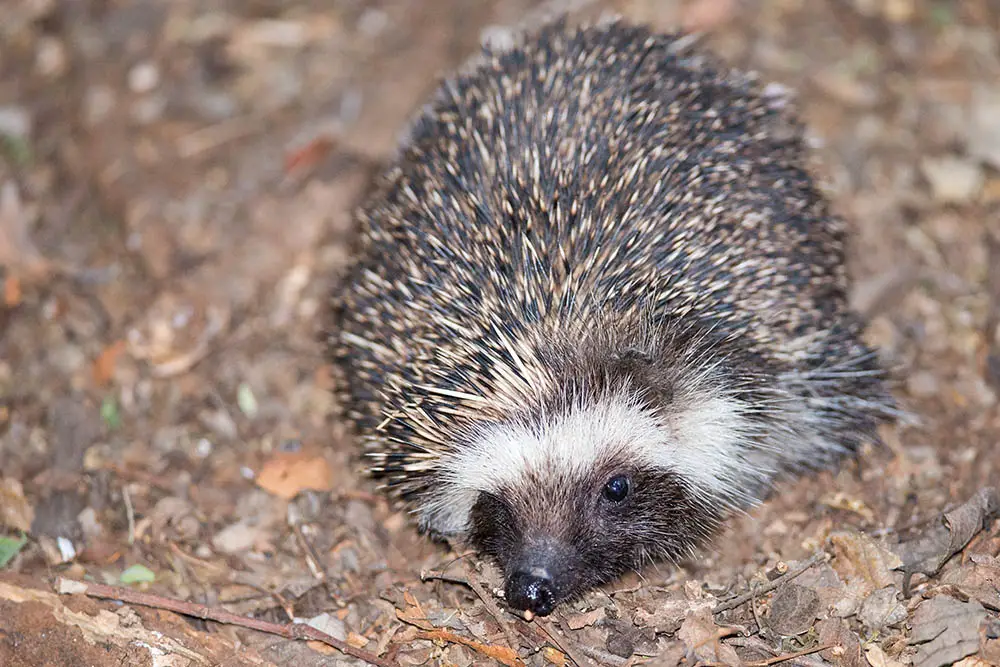
That’s not to say they can’t be spotted in suburban gardens nibbling at this and that before scurrying back under the hedge borders and into the night. Although suburban areas pose more of a risk, food is plentiful, and as fairly slow-moving mammals, escaping to the country can be a mammoth undertaking.
If they can get there, the Bushveld, a sub-tropical woodland ecoregion of Southern Africa, provides the optimal living environment for these adorable, spiky so-and-sos.
Southern African hedgehogs are also known to enjoy a good hole in the ground or burrow, as it offers them extra protection. Females, in particular, will seek out these more permanent residences when they’re expecting or nursing young. Males will only try to find a semi-permanent home to overwinter in.
Diet
Originally insectivorous mammals, meaning they dined on insects exclusively – earthworms and crickets being particular favorites – the Southern African hedgehog’s diet has undergone some changes over the years.
These days, due to the impact of human activity and habitat loss, they’re a mostly omnivorous bunch.
Some of their meals are fairly predictable. Slugs, for instance, are a tasty treat, as are grasshoppers and beetles. But it may shock you to learn that some small invertebrates such as frogs and lizards are also on the menu.
While these foodstuffs that sound to be equal parts slimy and crunchy don’t appeal to us, the Southern African hedgehog does what it needs to survive, and if it stumbles into a pile of our trash, it’s a lucky day.
The suburban go-getters of the Southern African hedgehog population are also known to sneak a mouthful or two of cat or dog food if given half a chance.
As water is fairly hard to come by in Southern Africa, especially from a free-flowing source, these hedge-dwellers have to source all their moisture from their food — suddenly a slimy frog doesn’t sound so bad, ay?
These hedgehogs are exceptionally talented foragers. On a good night, they’ll consume roughly 30% of their body weight — that’s one hedge-load of beetles.
Being that they’re hibernators, they have no choice but to be brilliant seekers of food. To survive a long nap through a single cold season, a Southern African hedgehog must weigh a whopping 500 grams. That’s a THICK hedgehog, folks.
Predators
Fortunately for our spiky, southern friends, they don’t have many natural predators to worry about.
There are twelve species of owl hoo-hoo-ing the night away across Southern Africa, and there’s no doubt that some of them will fancy a spot of hedgehog for dinner every now and again.
Eagles are also a threat, especially as the majority of eagle species reside on the African Continent. The good news is that eagles tend to hunt in the daytime when our pointy pals are tucked safely away under leaves, hiding in holes, or cozying up in a hedge.
Their spines provide a decent amount of protection from these natural foes, and although they normally move quite slowly, when threatened, they can reach speeds of 6 to 7 kilometers per hour. Sonic the hedgehog’s got nothing on these guys!
The biggest threat the Southern African hedgehog faces is, well…it’s us. Frequently hunted for human consumption (weird, I know), there’s a good reason they stay hidden during the day.
As you’d imagine, vehicles are also responsible for a significant amount of hedgehog deaths in Southern Africa.
What’s more, some cultures on this side of the continent believe that the smoke derived from burning their spines and dried meat will keep spirits away, giving hunters yet another reason to kill these wonderful animals.
It’s also believed in some southern African regions that the fat of a hedgehog has medicinal qualities and can be used to treat earaches in children.
It’s sad that we can’t just live in harmony with these harmless creatures, especially as in certain ways, their behaviors are useful to us, which brings me to my next point.
Behavior and Temperament
The Southern African hedgehog is a mostly nocturnal animal, so you’re only likely to catch a glimpse of them when they leave cover during nightfall.
A hedgehog home range typically spans roughly 200 to 300 yards from their area of residence. It gives them a wide enough range to forage and makes escaping easier in the event of an emergency. They’re known to wander up to 5km per evening.
They tend to live extremely solitary lives and do not crave companionship, even during hibernation; however, they are known to interact with one another from time to time.
Communicating via a lot of snuffling, snorting, and growling, they’re perfectly capable of being civil with one another, but they’re also territorial and will engage in combat from time to time, especially if two sexually mature males run into one another.
Despite their numerous spines, in-fighting normally involves a series of headbutts, and sometimes they can inflict serious damage on one another.
A gardener’s best friend, they often hunt a lot of the pests that feed on garden plants, yet for the most part, they themselves will leave vegetation untouched.
The wild Southern African hedgehog is generally a very docile, timid creature, but South African Pygmy variants are known to become quite affectionate pets.
That said, even these domesticated hybrids of the four-toed hedgehog and the Algerian hedgehog don’t crave companionship.
Hibernation
This species of hedgehog hibernates throughout the winter period in semi-permanent residences. In the months leading up to winter, they’ll eat more and more during foraging expeditions in order to put on the necessary weight to survive the season.
Studies show that heterothermy plays a role in keeping them alive during winter stasis. This means they both self-regulate their temperature and allow thermal influence from their surroundings.
Mating, Litters, and Lifecycle
Courtship rituals of the Southern African hedgehog can last for days on end. It all starts during the summer period, with the male hedgehog walking in circles around the female, likely to keep her in one place as well as to fend off other suitors.
The female hedgehog will let this flirtation go on, denying the male until she feels she is ready to mate. After the deed is done, the male hedgehog lights a cigarette and relaxes in bed…just kidding, the reality of the situation is less hilarious and far more disgusting.
The male releases a gum-like paste into the female’s genitals, forming a natural plug, ensuring his seed reaches and fertilizes her eggs — not so cute anymore, huh?
Gestation usually takes about 35 days, and litters are birthed anywhere from October right through to March. The female Southern African hedgehog can become pregnant with anywhere between 1 and 10 infants, but litters of 4 or 5 are the norm.
A newborn Southern African hedgehog weighs roughly 10 grams, and they’re completely blind and hairless. Unfortunately, for the mother, their spines are already in place (ouch!), but they’re quite small.
Until the infants are developed enough to eat solid food (if you can call a slug solid), they suckle the mother.
After around 14 days, the hoglets open their eyes and view their surroundings for the first time. Then, between the fourth and sixth week, they shed their spines in a process known as quilling. Hedgehogs quill several times throughout their life.
At this point, their fur will have grown in, so they resemble miniature versions of adult hedgehogs. The six-week stage is also when they’ll be weaned and taken on their first foraging expeditions by their mother — Okay, they’re cute again.
Soon after this event, the mother encourages them to leave the nest and start their own independent lives driven only by the impulses hardwired into their genetic code.
Reaching sexual maturity after only 68 days, they’re ready to continue the circle of life. Females can birth several litters a year, but their relationships are monogamous. Males play no role in rearing the hoglets.
Southern African hedgehogs have an average lifespan of three years in the wild, but they can live for up to seven years when bred in captivity.
Are They Legal to Own as Pets?
It is illegal to keep a wild Southern African hedgehog as a pet, but the South African Pygmy hedgehog is different. Not only are they popular in South Africa, there are many states across the U.S. that deem them suitable house pets.
In fact, the only states in which owning any sort of hedgehog is still illegal are Hawaii, Pennsylvania, California, and Maine, although you may be able to source the necessary permits for exemption.
Looking after a domesticated hedgehog is much like caring for a hamster or a mouse in that they require a cage, a wheel to run in, a place to hide, and plenty of food and water.
Health Issues
While there are no known genetic disorders common to the wild Southern African hedgehog, they usually play host to the Acanthocephalan parasite, a thorny-headed worm that lodges to the gut wall.
Conservation Status
There are no exact population numbers on record for the Southern African hedgehog, but they are incredibly widespread throughout their western and eastern ranges.
In light of this, they’re classified as Least Concern (LC) on the IUCN Red List, meaning their numbers are perfectly stable despite being hunted by humans.
Final Thoughts
There you have it, friends. The Southern African hedgehog may not be a suitable pet, but you can still show your love for these amazing creatures from afar, and perhaps even leave out some food for them if you’re ever in one of their two ranges.
They’re adorable, nocturnal, fiercely independent creatures that hibernate in winter, love the Bushveld of Southern Africa, and, of course, a nice long forage!

